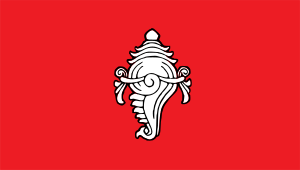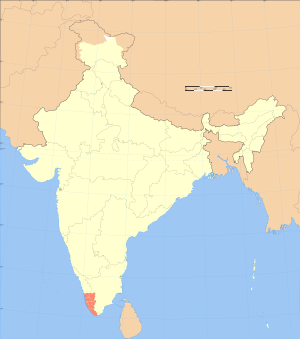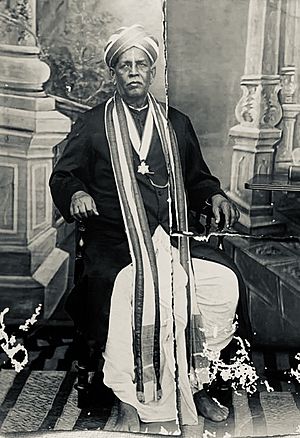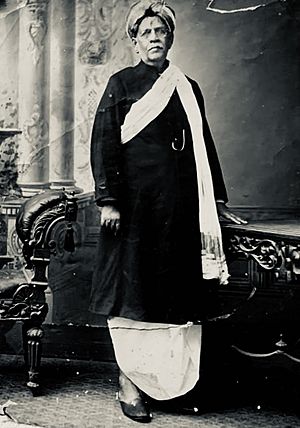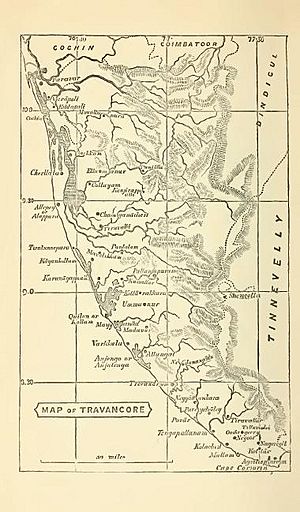V. Nagam Aiya facts for kids
Quick facts for kids
Dewan/Dewan Bahadur, Sir
Veeraraghavapuram Nagam Aiya
|
|
|---|---|

Portrait of Sir V. Nagam Aiya
|
|
| Dewan Peishkar of Travancore | |
| In office 1870–1906 |
|
| Personal details | |
| Born | 1850 Veeraraghavapuram, Madras Presidency, British India |
| Died | 1917 |
| Children | Lalitha Janaki |
| Alma mater | Maharajah's College, Madras University |
| Occupation | Civil Servant, historian, politician, administrator |
Diwan Bahadur Sir Veeraraghavapuram Nagam Aiya (c. 1850 December – 1917) was an important Indian figure. He was a historian, a government worker, and a writer. He served as the Dewan (like a Prime Minister) in the old princely state of Travancore.
The title "Dewan Bahadur" was an honor given during the British rule in India. It was awarded to people who did great service for the country. It was similar to a high honor in Britain. The word "Dewan" means Prime Minister in India, and "Bahadur" means brave. This title was higher than "Rao Bahadur." Sometimes, people with the "Rao Bahadur" title were given "Dewan Bahadur." Prime Ministers of Indian states were also known as Dewan. They might get the "Dewan Bahadur" title when they became Dewan.
Contents
Early Life and Education
Nagam Aiya was born in December 1850. His birthplace was Veeraraghavapuram, a small village in Tamil Nadu. His family originally came from Andhra Pradesh. They moved to different places before settling in Travancore. His ancestors worked for the Maharajah of Travancore.
Nagam Aiya moved to Thiruvananthapuram as a child. He went to H.H. The Maharajah's High School and College. He was taught by European teachers. He was a very bright student. He finished his Matriculation in 1865. He then passed his F.A. in 1866.
In February 1870, he became the first person to graduate from Maharajah's College. Because his family was poor, he started working as a clerk. He earned a small salary of Rs 7/- after his Matriculation. His success as the first graduate caught the eye of H.H Sri Ayilyam Tirunal. He was then appointed as an Assistant Professor. He taught history and mathematics at his old college.
Working for Travancore
Soon, Sir T. Madhava Rao, who was the Dewan (Prime Minister) at the time, hired him. Nagam Aiya became a clerk in the Dewan's English Office. He earned Rs. 50/-. His career grew quickly from then on. In 1872, he became a Tahsildar (a local administrator).
By 1880, he was a Deputy Peishcar. In 1883, he became the Dewan Peishcar. He was only 24 years old when he led the first census in Travancore. A census counts all the people in an area. He held this important position for 11 years. He also served as the Acting Dewan for Travancore five times. In 1904, he was chosen to be the Dewan by H.H. Sri Mulam Tirunal. He retired in February 1908 after 38 years of government service.
Besides his main duties, he had many other tasks. He was in charge of the Census in 1878, 1881, and 1891. He wrote the first Census Report for Travancore in 1875. People were amazed by his work. One report said he handled his duties like games. He also managed the Revenue Survey and Settlement in 1892.
Creating the Travancore State Manual
Another big job for Nagam Aiya was writing the first Gazetteer of Travancore. This book was called Travancore State Manual. He started working on it full-time in 1904. The government asked him to create it like other District Manuals in Madras. He finished this huge work by 1906. It was published in three large books.
He was also a member of the Travancore Legislative Council. This was from 1892-99 and again from 1905-1908. In 1892, he became a Fellow of the Royal Historic College of London. This was a great honor. In January 1910, he received the "Dewan Bahadur" title. This was for his excellent service to the state. He passed away in 1917 in Trivandrum at age 67.
Shaping Modern Kerala
Thiruvananthapuram, now the capital of Kerala, was once the capital of Travancore. In 1956, Travancore, Cochin, and Malabar joined together. This formed the state we now know as "Kerala."
Travancore became a very successful princely state under British rule. It was known for its progress in education, government, and social improvements. The Kingdom of Travancore existed from about 870 CE until 1949 CE. It was ruled by the Travancore Royal Family. At its peak, it covered much of modern-day central and southern Kerala. It also included the Kanyakumari district in Tamil Nadu.
The Maharajah of Travancore, Rama Varma, asked Diwan V. Nagam Aiya to create the 'Travancore State Manual'. This book covered many things about the Kingdom. It included details about its government, economy, and resources. Nagam Aiya did a lot of original research for this book. The result was a huge set of books. They were over 1820 pages long, published in three volumes. These books are still available today.
Nagam Aiya started working on this project full-time in December 1904. He likely collected information for it even before then.
What's in the Travancore State Manual?
Diwan V. Nagam Aiya's Travancore State Manual from 1906 is a massive history book. It is 1820 pages long, split into three volumes. It doesn't just cover the history of Travancore. It also looks at many other features of the region.
The books include detailed studies of the land. They cover its physical features, geology, and climate. They also describe the plants (flora) and animals (fauna). You can find information on archaeology too.
The manuals describe mountains, rivers, and coastlines. They talk about ports and shipping. They also cover the economic geology of the area. You can learn about trees, medicinal plants, and flowers. Birds and animals are also included. The books discuss archaeology, buildings, and old coins. They have details on inscriptions and forts. There are sections on population, languages, and the economy.
The books also have many photographs. They show pictures of stone inscriptions found across the kingdom. The later parts of the book focus on the history of the areas that became Travancore. It starts with old legends. Then it moves to the times of ancient kings.
The manual also mentions ancient trade records. These records talk about the Malabar and Travancore coasts. It includes details about early missionaries and neighboring kingdoms. It discusses the Portuguese in Malabar and Travancore. It also covers the attacks by Sultan Tipu.
The rebellion led by Velu Thampi Dalawa is also discussed. Nagam Aiya analyzed this event deeply. He did not fully agree with Velu Thampi's actions.
All the rulers of Travancore are covered in detail. This includes King Marthanda Varma.
Nagam Aiya's Goals
Diwan V. Nagam Aiya explained his goal for the Travancore State Manual. He wanted to give a complete picture of Travancore. He aimed to show the land, its people, and its history. He wanted to cover its nature, art, and government. He also included its forests, animals, and travel information. He wrote about its farming, trade, and education. He also described the people's social and religious life.
He hoped that someone new to Travancore could learn all this from his book. He wanted them to understand it better than if they lived there for 30 years. He believed he made a good first attempt, even with any small errors. This was a new kind of project.
Nagam Aiya knew many important people of his time. This included Raja Ravi Verma, a famous Indian painter. Raja Ravi Varma mentioned meeting Nagam Aiya many times in his diary. They met at Nagam Aiya's home and the Maharajah's palace.
Where to Find His Works
The Travancore State Manual is available in print. You can also find digital copies online. These can be downloaded from websites like archive.org. They are also available from the Trivandrum Public Library. The archives of the Travancore Royal Family also have them.
- Travancore State Manual - Volume 1: LINK
- Travancore State Manual - Volume 2: LINK
- Travancore State Manual - Volume 3: LINK
Another digital version is also on archive.org: LINK
You can also find physical copies of the books for sale online. This work is important for understanding the past of "Gods own country," also known as Kerala. Kerala is even named one of the ten best places in the world by National Geographic Traveler.


